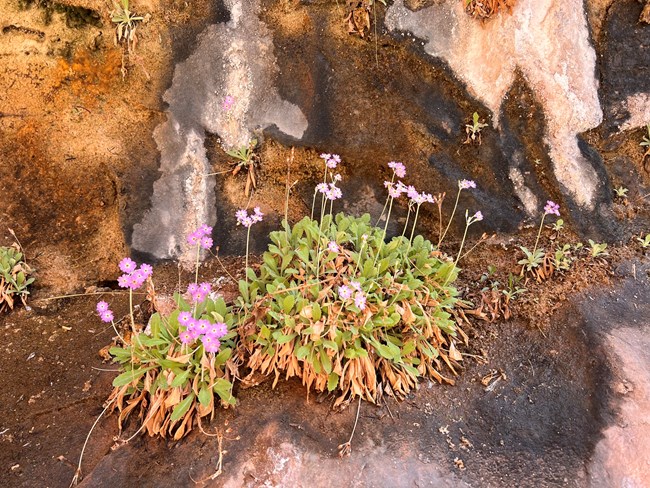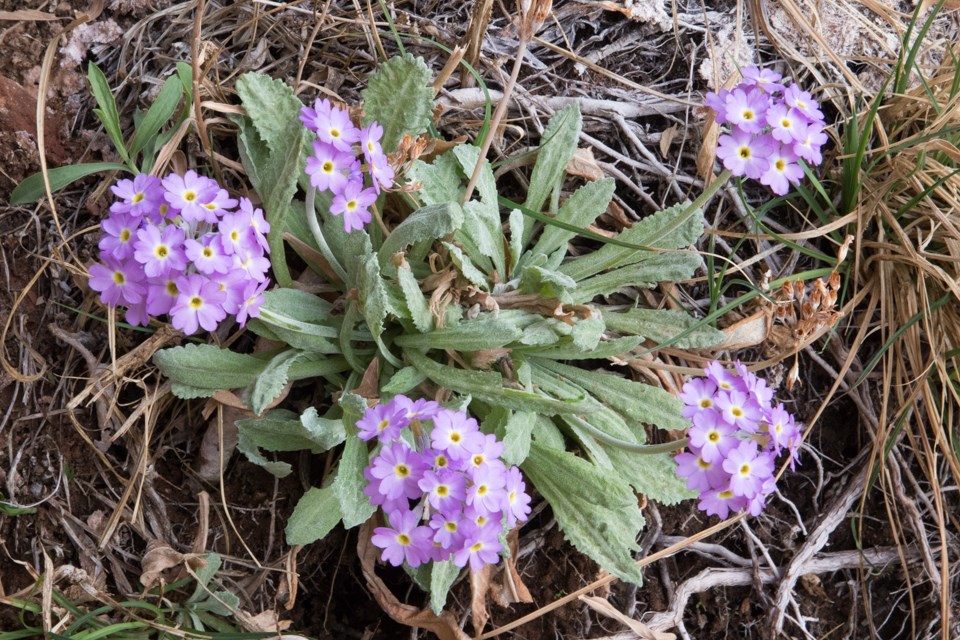Last updated: September 18, 2025
Article
Get to Know the Plateau - Cave Primrose

The Get to Know the Plateau series spotlights a variety of species that live on the Colorado Plateau, a unique area comprised of portions of Arizona, Colorado, New Mexico, Utah, and many sovereign Tribal Nations.
Cave Primrose - Primula specuicola

Amy Washuta/NPS
Habitat and Ecology
Cave primrose can be seen literally hanging out on the plateau in hanging gardens and seeps at broad elevations ranging between 380-2,350 meters (1,250-7,700 ft). Preferring canyons and tributaries of the Colorado River, amongst alcoves, entradas (entrance ways) of Navajo sandstone formations, and limestone sediment. It can be found at places lke the Diné (Navajo) Nation specifically in Chinle Wash and canyons at Navajo National Monument. Glen Canyon National Recreation Area is another known site for this rare plant, as well as along the Grand Canyon National Park river corridor. Bearing kinship to the Primulaceae (Primrose) Family, cave primrose is the only species of this family in all of Arches National Park in southern Utah. Its subtle flowers draw in attention from key pollinators such as bees, moths and butterflies.

Sophie Perry (CC BY-NC)
Description
Flowering typically between March-May, lends this species to also commonly be known as Easter Flower. Umbels, or a clustering of flowers at the end of a leafless stalk, will range between 5-40 individual flowers. Their color is whitish to pink, tubular in form, 1.5 cm (0.6 in), with 5 stamens and 1 pistil. The corolla tube displays a rim of yellow. With natural allure and beauty, Cave primrose stands erectly from its basal leaf base, 6.1-28.5 cm (2.4-11.2 in) tall. Leaves are spatula shaped, simple and toothed. The fruit matures to a capsule bearing seed.
Conservation Status and Threats
Cave primrose is endemic to the Colorado Plateau and recognized as C3 Federal Species of Concern by the US Fish & Wildlife Service, refering to species that are not currently listed as threatened or endangered but are still of conservation concern. The Navajo Nation Division of Natural Resources and Department of Fish and Wildlife gives cave primrose a G4 status. This indicates there is not enough information to denote a higher rank, yet efforts are continually occuring to determine the need to categorize differently or remove from the list.
Groundwater pollution, and drying climate pose a threat to the rare habitat of the cave primrose, as does direct human disturbance. A 60 meter (200 ft) buffer zone around the habitat to avoid disturbance is recommended.
Of Note
Genus Primula, meaning “little firstling” refers to it being one of the earlier flowers to bloom. Species specuicola, or “cave dwelling” refers to the specific habitat to which it grows.
Although common names may assume the relation of cave primrose to evening primrose, they are actually from different families - Primulaceae and Onagraceae.

Tim Heaton (CC BY-NC)
References
Elpel, Thomas J. 2018. Botany in a Day. Edition 6.1.
Huisinga, Kristin, Lori Makarick, and Kate Watters. 2006. River and Desert Plants of the Grand Canyon
Roth, Daniela. 2008. Species account for Primula specuicola. Navajo Natural Heritage Program, Navajo Nation Endangered Species List Version 4.20
Written by Ashley S. Doyle for the Southern Colorado Plateau Network (2025).
Printable .pdf version
Tags
- arches national park
- canyonlands national park
- capitol reef national park
- glen canyon national recreation area
- grand canyon national park
- navajo national monument
- rainbow bridge national monument
- species spotlight
- get to know the plateau
- native plant
- endemic plants
- southern colorado plateau network
- scpn
- capitol reef national park
- canyonlands national park
- glen canyon national recreation area
- grand canyon national park
- rainbow bridge national monument
